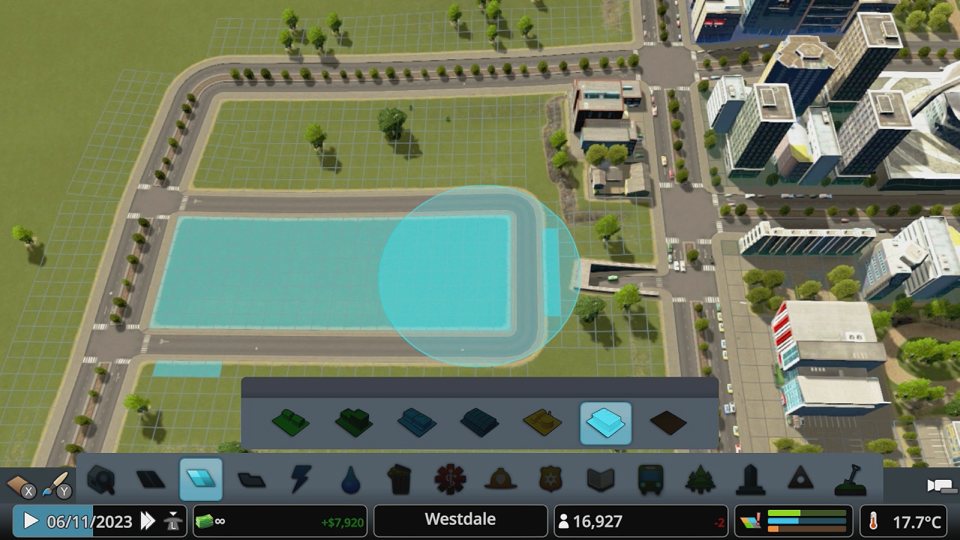Whatever dark arts Tantalus have had to indulge in to get Cities: Skylines to run on Nintendo Switch, I don’t really mind. The fact that they agreed to try and bring the game across to the console is worth a few pentagrams on its own, but there’s bound to have been some goat blood spilt in trying to get it run.
Last night’s surprise announcement of the game was preceded, for us, by a sneaky hands on preview with this version of the game at Gamescom, and I came out of it pleasantly, well… surprised! They’ve obviously made some cutbacks to get the game running, but they’re primarily on the visual side of things. The amount of traffic coursing through the arteries of your road network (or more likely, getting very, very stuck) haven’t really been dialled back, the simulation that the cities run on are preserved.
It’s impressive that this is possible on the mobile processor in the Switch, and even more impressive when you consider that the game can sometimes struggle on Xbox One and PlayStation 4. Naturally, its release on home console and the continued optimisations its seen alongside updates to Unity over the last eighteen months have helped. It’s through this that the Switch lets you adjust the game speed, which wasn’t available at the original release of the game on Xbox One.
So where have the cuts been made? Well, in the level of detail that you’ll see when zooming around the world. The game runs at 720p in handheld mode, Paradox told us, but there’s a lack of anti-aliasing and a very obvious amount of detail pop-in as you get closer to buildings, trees and scenery. Given the hardware, the even a moderate city seems to be able make the frame rate a juddering mess. Pull out to get an overview of the world and things quickly improve, as can simply tilting the camera down to avoid gazing too far off into the distance. It’s a problem with this version of the game and one that Paradox will continue to optimise around, but to help mitigate the issue, you can choose to lock the camera to a steep downward facing angle in the settings.

But one thing that is very useful is a new and more extensive tutorial that’s been developed specifically with the Switch in mind. It goes through the very basics of road placement, zoning for houses, business and industry, setting up a water supply, electricity and more, and while the game was always designed with a softly, softly approach of unlocking different utilities and services, this really goes root and branch for what Paradox hope will be an audience of newcomers to this style of game.
The control layout makes sense, even if it can be a bit esoteric at times – it’s been tweaked to Nintendo’s button layout, but if coming from PS4 or Xbox One, you can switch it round so that ‘B’ is the main interaction button and ‘A’ goes back. You simply navigate the building options laid out along the bottom of the screen, while holding ‘Y’ brings up a context sensitive radial menu that lets you switch between straight and twisty roads, delve into the city finances, and so on. Camera control is nicely handled with standard twin-stick controls for movement and tilt, while the trigger buttons are there to zoom in and out. The most unusual part of this is clicking the left stick to pause the game and having to hold it clicked in if you want to change the game speed.

One nice tweak is the inclusion of HD Rumble through the Joy-Con, in what’s a minor but pleasant little feature. When placing a service building, the Joy-Con rumbles, getting stronger the more impactful it will be for nearby citizens and businesses. Of course, you also have the on-screen overlay showing you the green zone that your school, police station, hospital, or whatever will have, but this helps to emphasise it for you when zoomed out and playing on the Switch’s built in screen.
It’s launched with the game’s first two expansions bundled in – Snowfall and After Dark – which added plenty of new features over the original game, with the city’s patterns changing through the day night cycle, which the blanket of snow that winter brings chilling your city and making you consider whether or not you’re going to pipe heated water to your citizens. The PS4 and Xbox One versions are racing ahead with both Natural Disasters and Mass Transit, and PC further still, but Paradox’s latest forays into console games have always been to dip a toe in with a foundational release, gauge interest, and build from there. We’ve seen it on other platforms, we’re going to see it with Stellaris, and it’s true of Cities: Skylines on Switch as well.

While we had a brief hands on a few weeks ago, the game is out now on Switch, so we’ll be spending a bit more time with it over the weekend and bring more in depth thoughts on its performance soon. How does the above screenshot hold up in real life, for example? And how does it deal with docked mode?
What I can say is that Cities: Skylines on Switch is a really pleasant surprise, not just in that Paradox and Tantalus decided to try and make it work, but that it works as well as it does. Having this game in a portable form is just fantastic, letting you manage your city’s waterworks while you’re on the bog, passive-aggressively vent your anger at train delays by improving your own public transport network, slash public funding for police while in lock up…. OK, maybe not that last one.



